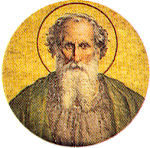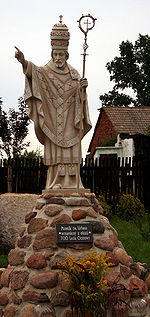Difference between revisions of "Pope Urban I" - New World Encyclopedia
(New page: :''"Saint Urban" redirects here. For other saints with this name, see Saint Urban (disambiguation).'' {{Infobox Pope| English name=Urban I| image=150px| birth_name...) |
m (→References) |
||
| Line 60: | Line 60: | ||
{{DEFAULTSORT:Urban 01}} | {{DEFAULTSORT:Urban 01}} | ||
| − | [[Category: | + | [[Category:religion]] |
{{Credit|202413092}} | {{Credit|202413092}} | ||
Revision as of 19:15, 3 April 2008
- "Saint Urban" redirects here. For other saints with this name, see Saint Urban (disambiguation).
| Urban I | |
|---|---|

| |
| Birth name | Urban |
| Papacy began | 222 |
| Papacy ended | 230 |
| Predecessor | Callixtus I |
| Successor | Pontian |
| Born | ??? Rome |
| Died | 230 Rome |
| Other popes named Urban | |
| Styles of Pope Urban I | |

| |
| Reference style | His Holiness |
| Spoken style | Your Holiness |
| Religious style | Holy Father |
| Posthumous style | Saint |
Pope Saint Urban I was pope from 222 to 230.
Born in Rome, Italy, he came to the See of Rome in the year that Roman Emperor Elagabalus was assassinated and served during the reign of Emperor Alexander Severus. He had been preceded by Callixtus I and was followed by Pontian.
He is mentioned by Eusebius in his history and is named in an inscription in the Coemeterium Callisti, but of his life nothing is known. Urban was elected pope after the death of Callixtus I on 14 October 222.
Urban I is the first pope whose reign can be definitely dated.[1] Seven of his successors have taken his name.
To Pope Urban is attributed a decree concerning the donations of the faithful at Mass:
"The gifts of the faithful that are offered to the Lord can only be used for ecclesiastical purposes, for the common good of the Christian community, and for the poor; for they are the consecrated gifts of the faithful, the atonement offering of sinners, and the patrimony of the needy."[2]
Legend
The story that was once included in the Catholic Church's Breviary on 25 May speaks of his numerous converts, among whom were Valerianus, husband of Saint Cecilia, and his brother Tiburtius, and states that he suffered martyrdom and was buried in the Coemetarium Praetextati. In reality Pope Urban I, whose feast as a saint is on 19 May,[3] but was confused with a Saint Urban whose feast was on 25 May and whom the ancient liturgical books describe as a martyr bishop of a place near Rome.[4]
The Urban of legend was credited with the miracle of toppling an idol through prayer.[5] It is claimed that after this act Urban was beaten and tortured before being sentenced to death by beheading.
He is invoked against storm and lightning and represented by: Vine and grapes; a fallen idol beneath broken column; a scourge; a stake and his severed head.
Art
Urban is found in various pieces of artwork that present him as a composite of these two Urbans. Often he is found sitting wearing the Papal Tiara, Papal robes and holding a sword pointed towards the ground. An example of such a depiction. Otherwise Urban may be portrayed wearing Papal garb and a Bishop's Mitre whilst holding a bible and a bunch of grapes. Examples: 1 and 2
Other less common depictions of Pope Urban are:
- after his beheading, with the papal tiara near him.
- as idols fall from a column while he is beheaded;
- scourged at the stake;
- seated in a landscape as a young man (Saint Valerian) kneels before him and a priest holds a book.
ReferencesISBN links support NWE through referral fees
- ↑ Kung, Hans. The Catholic Church: A Short History. New York; The Modern Library, 2003, p. 41
- ↑ Roman Breviary
- ↑ Martyrologium Romanum (Libreria Editrice Vaticana, 2001 ISBN 88-209-7210-7)
- ↑ Calendarium Romanum (Libreria Editrice Vaticana, 1969), p. 124
- ↑ Roman Breviary: Saint Urban began to make his orison to God; and anon the idol fell down and slew twenty-two priests of the law that held fire for to make sacrifice.
| Roman Catholic Popes | ||
|---|---|---|
| Preceded by: Callixtus I |
Bishop of Rome Pope 222–230 |
Succeeded by: Pontian |
| ||||||||||||||||
Credits
New World Encyclopedia writers and editors rewrote and completed the Wikipedia article in accordance with New World Encyclopedia standards. This article abides by terms of the Creative Commons CC-by-sa 3.0 License (CC-by-sa), which may be used and disseminated with proper attribution. Credit is due under the terms of this license that can reference both the New World Encyclopedia contributors and the selfless volunteer contributors of the Wikimedia Foundation. To cite this article click here for a list of acceptable citing formats.The history of earlier contributions by wikipedians is accessible to researchers here:
The history of this article since it was imported to New World Encyclopedia:
Note: Some restrictions may apply to use of individual images which are separately licensed.
